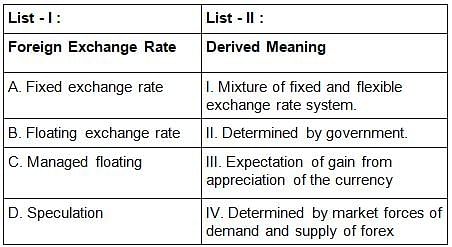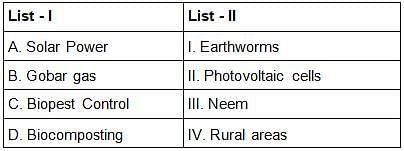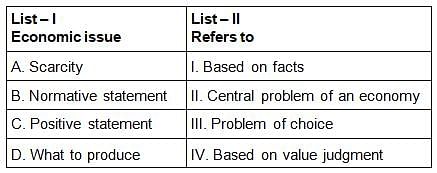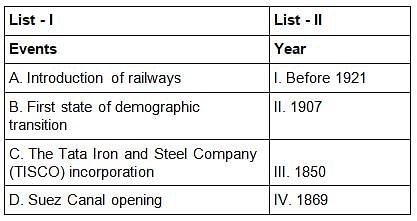CUET Economics Previous Year Solved Paper 1 (15 July 2022 Slot-2) - Humanities/Arts MCQ
30 Questions MCQ Test - CUET Economics Previous Year Solved Paper 1 (15 July 2022 Slot-2)
Match List - I with List - II.

Choose the correct answer from the options given below:

Which of the following is not a component of current account:
| 1 Crore+ students have signed up on EduRev. Have you? Download the App |
A change in the exchange rate of the Indian rupee and the British Pound from Rs.95 for a pound to Rs.100 for a pound will mean:
Which of the following will be included in national income, while using the income method to calculate the same: (Choose the correct option)
What is the value of real GDP is nominal GDP is Rs. 3,300 crores and GDP deflator is 150?
Which of the following explains the concept of depreciation?
A. An annual allowance for wear and tear of a capital good.
B. The capital good gradually used up in each year’s production process.
C. Cost of replacement of a capital good due to an accident.
D. Fall in the value of fixed asset due to unexpected change in technology.
E. Cost of the good divided by number of years of its useful life.
Choose the correct answer from the options given below:
If the value NVAFC is Rs. 200 crores, intermediate consumption is Rs. 100 crores and depreciation is given as Rs. 40 crores, what will be the value of GVAFC?
Identify the correct statements about the externalities as a limitation of GDP and welfare.
A. GDP as measured does not include external production of goods.
B. Inverse relationship between negative externality and welfare.
C. No relation between GDP and welfare.
D. Economic activities have both positive and negative externalities.
E. Producers are rewarded with profit for positive externalities.
Choose the correct answer from the options given below:
Coal used by a steel factory during the accounting year is a:
Suppose a TV manufacturing unit wants to raise its inventories from 1000 units to 2000 units during the year. Expecting sale of 5000 units during the year, the firm produces 5000 + 1000 = 6000 TV sets. Actual sale for the firm are 5000 TV sets during the year. This is an example of:
What will be the amount of initial reserves if Cash Reserve Ratio (CRR) is 20% and total credit creation is Rs. 500?
The currency issued by the Reserve Bank of India is called.
A. High powered money
B. Reserve money
C. Bank money
D. Monetary base
E. Fiscal base
Choose the correct answer from the options given below:
Identify which of the following measures taken by RBI will increase the money supply.
A. Increase in Cash Reserve Ratio
B. Decrease in Cash Reserve Ratio
C. Selling of a government bond
D. Buying of government bond
E. Decrease in Bank Rate
Choose the correct answer from the options given below:
Economic policies which have been adopted by both India and Pakistan are:
A. Mixed economy
B. Import-substitution
C. Green Revolution
D. Five Year Plans
E. Commerce system
Choose the correct answer from the options givenbelow:
Arrange the events related to rural credit in the chronological order.
A. Setting up of NABARD as an apex body for rural financial system.
B. Kudumbashree programme implemented in Kerala
C. Green Revolution initiates diversification of rural credit portfolio
D. India adopts social banking and multiagency approach.
Choose the correct answer from the options given below:
The objective of Karve committee was rural development with a focus on
Match List - I with List - II.

Choose the correct answer from the options given below:
Match List - I with List - II.

Choose the correct answer from the options given below:
The downward movement along the demand curve of a commodity is due to: Choose the correct option.
Budget set of a consumer is defined as:
Liberation of trade and investment regime was initiated in the Indian Economy in 1991 to provide for:
A. International competitiveness of industrial production.
B. Promotion of competitiveness of local industries.
C. Collection of higher tariffs.
D. Adoption of modern technologies.
E. Control over imports.
Choose the correct answer from the options given below:
Identify the feature not found amongst the poor. (Choose the correct option)
Which of the following is not a source of human capital?
The organization which is responsible for providing estimates on poverty in India is:
Match List - I with List - II.

Choose the correct answer from the options given below:
On May 12,2020, our Prime Minister raised a clarion call to the nation giving a kick start to the Atmanirbhar Bharat Abhiyaan to fight COVID-19 pandemic in India. Which long term goal of India’s five year plans does this campaign reflect? (Choose the correct alternative)
The contribution made by agriculture, industrial and services sector together contribute:
Which of the following statements is/are correct?
A. Primary sector is still the major source of employment in India.
B. All the public sector establishment and those private sector establishment are called formal sector.
C. Majority of Indian work force is employed in the informal sector.
D. Majority of Indian work force is regular salaried.
E. Growth of employment has decelerated.
Choose the correct answer from the options given below:
Which organization collects the data related to unemployment in India?
In an Economy, AD = Rs. 250 + cr + 0.6Y and at zero level of income consumption is Rs.150 crores. The value of autonomous investment will be:



















